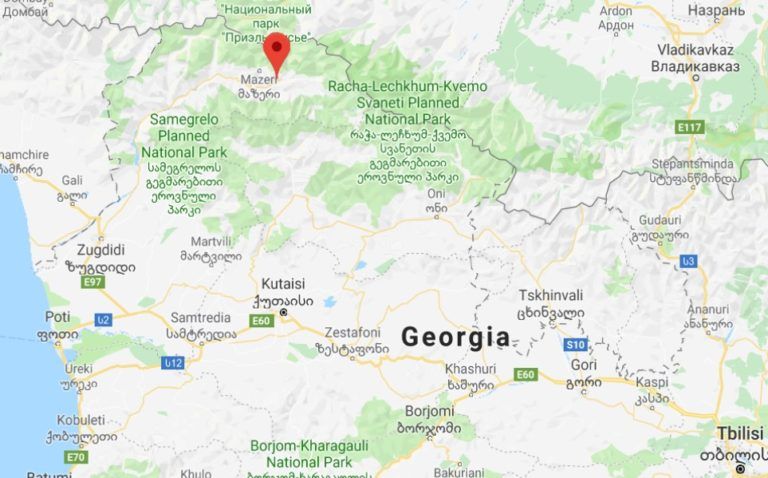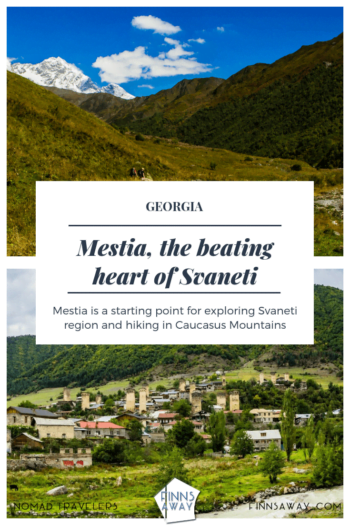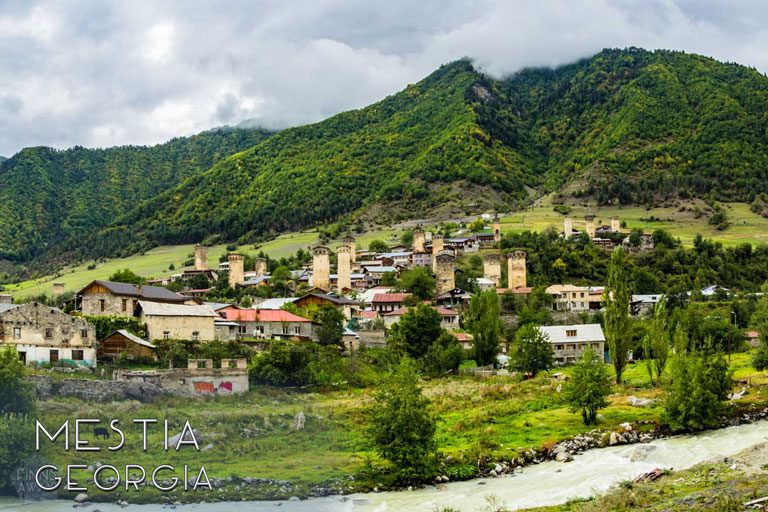
Mestia, the beating heart of Svaneti
After exploring the mountainous Svaneti region for five days, and trying to start writing about it, it’s hard to find the words to describe it. Even the pictures don’t do full justice to the beauty of Svaneti. I guess there is always some magic in mountains, and in Svaneti area the Caucasus Mountains are simply breathtaking.
The main purpose of our stay in Svaneti in early September was hiking along the mountain trails, but in this first post we’ll focus on shortly introducing Svaneti region and Mestia, the only actual town in Svaneti, and a natural starting point for trekking and skiing in this amazing mountain area.
About Svaneti
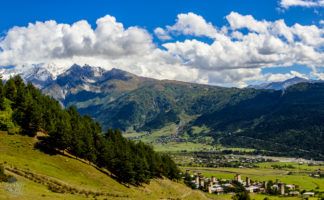
Svaneti is possibly the most picturesque area of Georgia, and one with noteworthy historical value. This wonderland of 4 000 to 5 000 meters high snow-topped mountains, green valleys, glaziers and wild rivers was for long hard to reach, and thus stayed very isolated for ages. Svaneti is inhabited by a Georgian ethnic subgroup of Svans, self-supporting people that also have their own, ancient and unwritten language. Farming has been the main source of living for thousands of years, and for many families it remains to be so, while increasing tourism can bring some side income.
Photogenic Svan villages, situated in valleys between mountain ridges, are typically built of stone and dotted with stone towers also known as koshki. These defensive towers, part of them dating back as far as to 9th century, were built to protect the villagers from invaders and internal conflicts. The whole Upper Svaneti region with it’s medieval-type villages and tower-houses is listed as a UNESCO World Heritage site. Officially Svaneti is not an actual region, but part of Samegrelo-Zemo Svaneti.
Svaneti and Mestia today
Since early 21st century Svaneti, especially Mestia, has developed a lot towards a tourism destination. The government of Mikhail Saakashvili decided to raise Svaneti on a map by building a new road, an airport and ski resorts, and investing in infrastructure and marketing of this unique area, also called “the Switzerland in the Caucasus”. Mestia town center got a new look with a main road lined with alp-village-style buildings, and the amount of guest houses, hotels and tour operators has exploded.
Even if Mestia today doesn’t look quite like an authentic Svan town anymore, it’s not fully spoiled. Development hasn’t changed the surrounding landscapes, and already the mini-bus ride to the town, along a winding mountain road, is like watching a nature documentary. Wooded hills, turquoise rivers, steep canyon walls, waterfalls, green meadows and higher and higher mountains the closer to Mestia you get. It’s true, that the main street looks like it’s built for tourists, but stepping out of it, the town still has a feel of a real mountain village. Cows, pigs, chicken and dogs roam along the unpaved side roads, that are lined with old stone houses and Svaneti towers.
Tourism in Svaneti will for sure continue increasing, and in 5 to 10 years Mestia, as well as the surrounding smaller villages may look something very different than now. New paved road from Mestia to Ushguli is almost ready, and some side effects of tourism are starting to show. If you’d like to see authentic Svaneti, it’s recommended to go to Mestia as soon as possible. On the other hand, there are still bunch of untouched mountain villages and trails further away from the busy regional capital, and it’s hard to imagine that those will be filled with new infra and swarms of tourists any time soon.
ExPloring Mestia
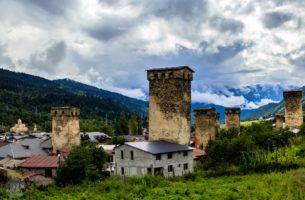
Most of the tourists in Mestia are there for the great outdoors, so instead of “samsonite-tourists”, we were accompanied with other backpackers wearing hiking shoes, which was delightful. Streets and terraces got full of smiling, tired and tanned (or rather partly burned) hikers late afternoon, and dinner tables of guesthouses were a place to share hiking experiences and other travel stories with fellow travelers after dark. If the Svaneti towers are a gorgeous sight during the day, in Mestia they get even better after sunset, as they are beautifully illuminated.
In between of hikes, Mestia offers a great base for resting and relaxing. You can find there all basic services, including small markets and ATMs, restaurants and even some bars with live music in the evenings. For sightseeing the town is small, but you could still spend couple of hours walking around it, and another few in the Svaneti History and Ethnography Museum, that also hosts a collection of 10th to 14th century icons. In addition, it’s fascinating to just follow the local life and the animals; you can watch puppies chasing piglets and chickens, and cuddle the huge but super-friendly Caucasian Shepherd Dogs that roam around the city center.
How to get there?
The quickest way to reach Mestia from Tbilisi or Kutaisi is by air. There are few flights per week to the small Queen Tamar Airport in Mestia, operated by Georgian airline Service Air, also known as Vanilla Sky. Flights tend to fill up early, so if planning on flying to Mestia, book your tickets well in advance. You should also be prepared for changes in schedule, since the flights over the mountains can get canceled or delayed due to weather conditions.
Overland transportation to Mestia runs via city of Zugdidi, on the lowlands southwest of Mestia. Mini-bus ride from Zugdidi to Mestia takes roughly three hours, along a scenic, paved mountain road. Zugdidi is well connected to all major cities in Georgia; from Tbilisi an overnight train is a popular option, and Kutasi and Batumi are roughly three-hour bus ride away.
Where to stay?
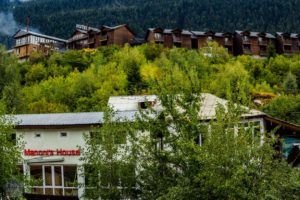
There are plenty of accommodation options in Mestia, from simple home stays to luxurious hotels. In the peak season, especially in August, you should still book ahead. Guesthouses usually offer meals, and you can choose to include them or not. Svaneti meals (as Georgian meals in general) in guesthouses are sizable and filling, and there usually are various dishes, also vegetarian options. When we were in Mestia, we stayed in Manoni’s Guesthouse. It’s a cozy, affordable and popular option with small double rooms, dorms and apartments, and the helpful owner Manoni speaks English. Price for a double room without meals was 40 lari, which is roughly 13 euros, and meals (breakfast and dinner) cost 10 lari each (3,3 €).
There are also some guesthouses in the surrounding small mountain villages, offering more peaceful stay than Mestia, or a comfortable option for staying overnight during longer hikes. You can find part of the guesthouses in services like booking.com, but there are plenty that can’t be booked in advance, instead just by asking around when you arrive in a village. Even if the actual guest rooms would be full, the friendly locals most likely will arrange some place to stay. Carrying your own camping gear enables staying outside the villages in the middle of mountain wilderness. Wild camping is legal in Georgia, just remember to do it responsibly, and take into account that the nights in the mountain areas tend to be very cold, also in summer.
Related post: 3-4 days hike from Mestia to Ushguli
Have you traveled in Svaneti region or are planning to? Feel free to share your thoughts in comments!
Where to stay?

There are plenty of accommodation options in Mestia, from simple home stays to luxurious hotels. In the peak season, especially in August, you should still book ahead. Guesthouses usually offer meals, and you can choose to include them or not. Svaneti meals (as Georgian meals in general) in guesthouses are sizable and filling, and there usually are various dishes, also vegetarian options. When we were in Mestia, we stayed in Manoni’s Guesthouse. It’s a cozy, affordable and popular option with small double rooms, dorms and new apartment building, and the helpful owner Manoni speaks English. Price for a double room without meals was 40 lari, which is roughly 13 euros, and meals (breakfast and dinner) cost 10 lari each (3,3 €).
There are also guesthouses in the surrounding small mountain villages, offering comfortable option for staying overnight during longer hikes. You can find part of the guesthouses in services like booking.com, but there are plenty that can’t be booked in advance, instead just by asking around when you arrive in a village. Even if the actual guest rooms would be full, the friendly locals most likely will arrange some place to stay. Carrying your own camping gear enables staying outside the villages in the middle of mountain wilderness. Wild camping is legal in Georgia, just remember to do it responsibly, and take into account that the nights in the mountain areas tend to be very cold, also in summer.
Related post: 3-4 days hike from Mestia to Ushguli
Have you traveled in Svaneti region or are planning to? Feel free to share your thoughts in comments!

